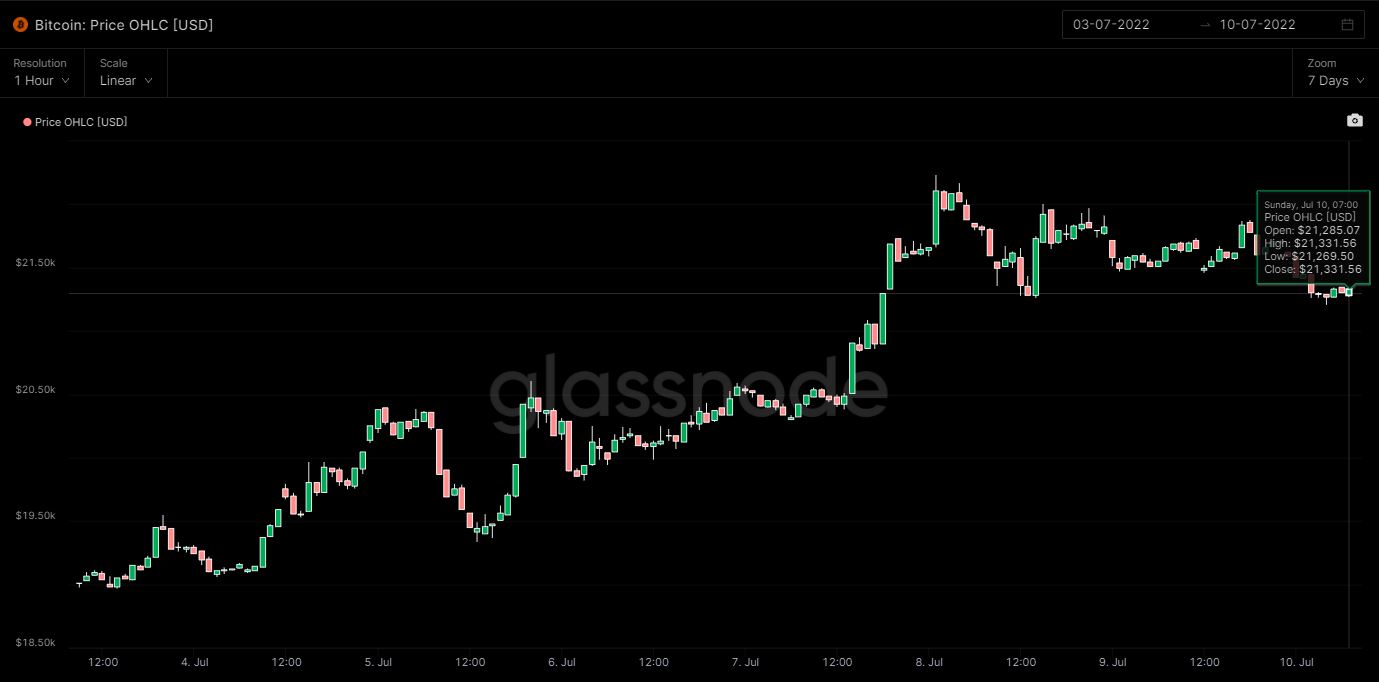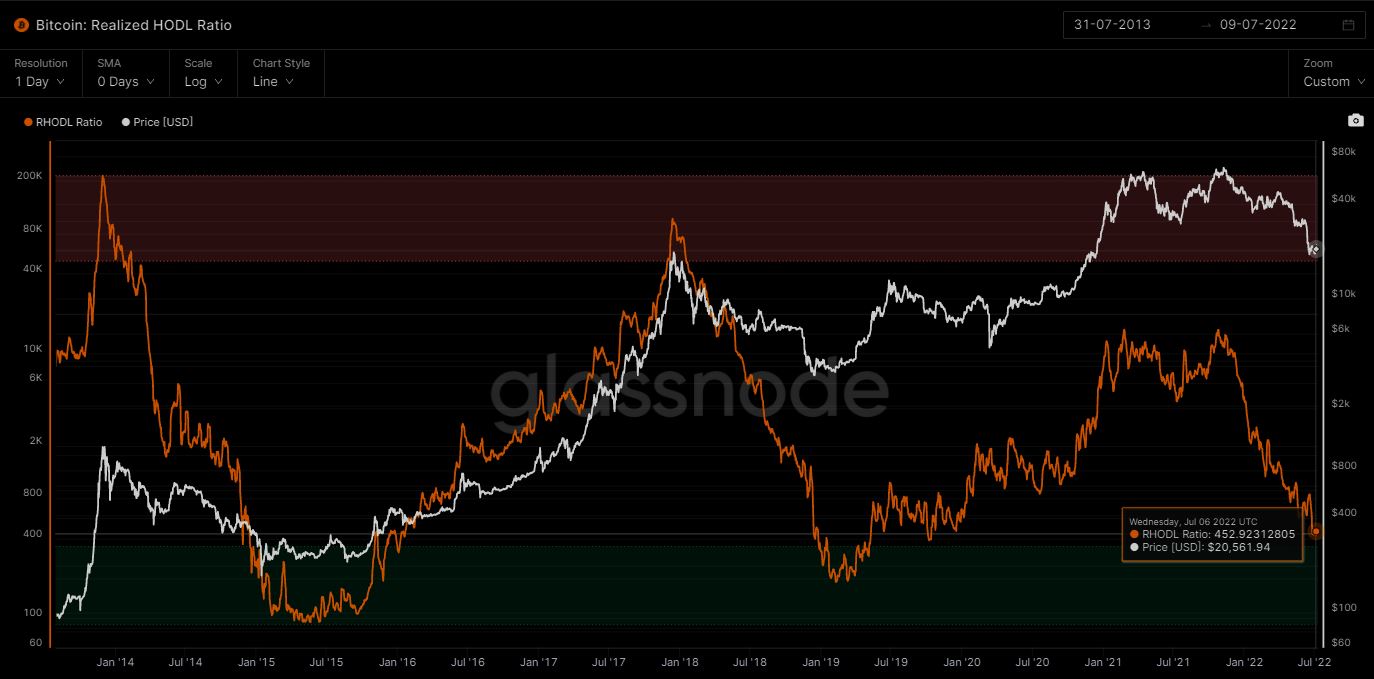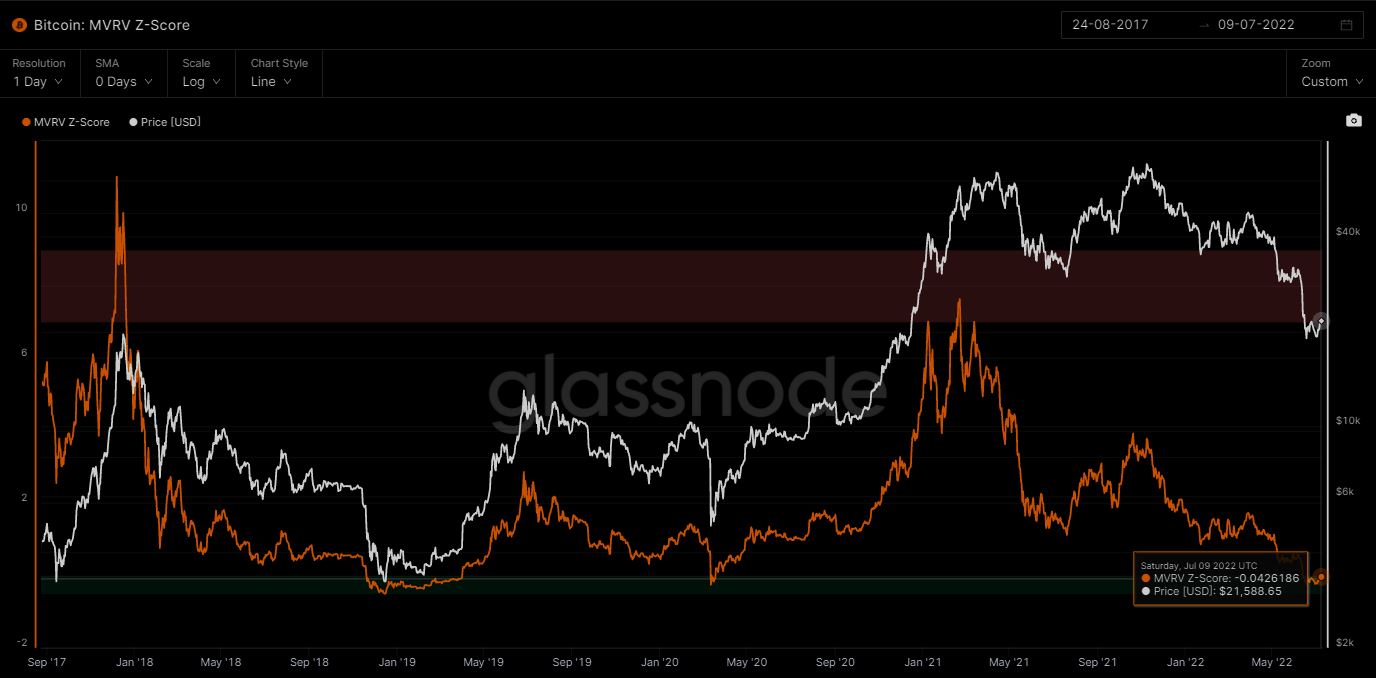7 minutes reading time
- Digital assets
Bitcoin posted consistent price increases in the first half of last week but flattened over the weekend. The dominant cryptocurrency continued to oscillate between US$17,500 and $US22,500. Market indicators and crypto pundits both seem to be more confident a market bottom is near, however another high-profile digital asset firm’s bankruptcy highlights there are still issues to be addressed.
At the time of writing, bitcoin is at US$21,328.
Ethereum returned 12.41% vs bitcoin’s 11.53% for the week.
Bitcoin’s market cap grew to US$407.1B, while the total crypto market sits at US$944.5B. Bitcoin’s market dominance increased to 43.1%.
| Price | High | Low | Change from previous week | |
| BTC (in US$) | $19,061 | $22,314 | $19,063 | 11.53% |
| ETH (in US$) | $1,189 | $1,262 | $1,044 | 12.41% |
Source: CoinMarketCap. As at 10 July 2022. Past performance is not indicative of future performance. Performance is shown in US dollars and does not take into account any USD/AUD currency movements.
Source: Glassnode. Past performance is not indicative of future performance.
News we’re watching
Mt. Gox to return 150,000 BTC
Gone but not forgotten, Mt. Gox’s rise and demise is still one of the most volatile the crypto industry has ever seen.
The Japanese-based crypto exchange Mt. Gox was launched in 2010 and by 2013 it was handling close to 70% of all bitcoin transactions. The exchange was notorious for security breaches, halting withdrawals and losing bitcoins. Unsurprisingly, it was the go-to place for hackers.
Some of the more notable events from Mt. Gox include hackers changing the price of bitcoin to 1 cent and purchasing thousands of coins. Earlier, someone posted the entire user database of Mt. Gox for sale on the web. But in 2014 Mt. Gox filed for bankruptcy – what finally brought the exchange to its knees was the reported loss of 850,000 BTC, totalling 7% of available BTC and worth US$473M at the time.
Soon after, the exchange managed to recover 150,000 BTC. But in a similar fashion to the timeliness of their withdrawal processing, those 150,000 coins have only just become available for repayment to investors more than eight years later. This is great news, but crypto pundits are warning about the price impact if these coins flood the market. The price of bitcoin has increased 60-fold since the bankruptcy. This leaves many investors with huge unrealised gains, even if only ~17% of their original balance is returned to them.1
Sam Bankman-Fried still has “a few billion” to support the crypto industry
Sam Bankman-Fried (SBF) may not have finished his spending spree.
In a recent interview with Reuters, SBF said he and his company still have “a few billion” to help struggling firms that may pose a risk of contagion given default. SBF’s support primarily comes from FTX Ventures, his US$2B venture capital investing arm of FTX. However, it’s not the only avenue he can use. SBF recently revealed he had personally taken a 7.6% stake in Robinhood Markets Inc, spurring rumours he might purchase the struggling platform. When asked about the purchase, SBF stated “FTX has shareholders and we have a duty to do reasonable things by them and I certainly feel more comfortable incinerating my own money.”
SBF continues to be crucial to the digital assets sector. When asked about the support he’s given so far, he stated “The goal of the bailouts was to protect customer assets and stop contagion from ricocheting through the system… having trust with consumers that things will work as advertised is incredibly important and if broken is incredibly hard to get back.”2
Voyager Digital declares bankruptcy
As previously discussed, crypto lender Voyager Digital suffered huge losses from its exposure to the now-bankrupt crypto hedge fund, Three Arrows Capital (3AC).
Voyager itself announced last Wednesday that it had filed for Chapter 11 bankruptcy*, owing money to an estimated 100,000 creditors. SBF’s Almeda Research is the largest creditor, owed around US$75M. In their announcement, Voyager explained how the “prolonged volatility and contagion in the crypto markets” and the default of 3AC have required it “to take deliberate and decisive action now.” According to the bankruptcy filing, the firm selected the option that estimates their assets at between US$1B and US$10B, and liabilities of a similar amount.
3AC filed for Chapter 15 bankruptcy, which allows the firm to shield US assets from creditors. This made it extremely hard for Voyager to recover the 15,000 BTC and US$350M worth of USDC that 3AC defaulted on.3
*Chapter 11 of the United States Bankruptcy Code is frequently referred to as a “reorganization” bankruptcy. This type of bankruptcy puts a hold on all civil litigation matters and allows companies to prepare restructuring plans while remaining operational.
On-chain metrics
Bitcoin (BTC): Realised HODL Ratio
The Realised HODL Ratio is a market indicator that looks at the ratio of transactions between short term holders (1 week) versus long term holders (1-2 years). When the RHODL Ratio is in the red band, it is viewed by some as an indication of an overheated market. When it is in the green band, it has historically been viewed by some as an indicator of a market bottom.
Looking at data from on-chain analytics company Glassnode, the ratio never reached an overheated status at the previous peak of US$60,000. But it is currently approaching the green band, which may indicate a market bottom is near.
Source: Glassnode. Past performance is not indicative of future performance.
Bitcoin (BTC): MVRV Z-Score
The MVRV Z-Score is a market indicator which is used to assess when bitcoin is over/undervalued relative to its “fair value”. When market value is significantly higher than realised value, it has historically tended to indicate a market top (red zone), while the opposite has tended to indicate market bottoms (green zone). Technically, MVRV Z-Score is defined as the ratio between the difference of market cap and realised cap, and the standard deviation of all historical market cap data.
The MVRV Z-Score currently indicates bitcoin might be experiencing a market bottom. It has successfully indicated market bottoms two other times in the last five years
Please note that neither of these indicators should be taken as definitive indicators.
Source: Glassnode. Past performance is not indicative of future performance.
Altcoin news
Polkadot has announced a new governance model for their blockchain.
Polkadot (DOT) is an open source blockchain platform and cryptocurrency. It provides interconnectivity and interoperability between blockchains, by enabling independent chains to securely exchange messages and perform transactions with each other without a trusted third-party. Gavin Woods, who played a fundamental role in Ethereum’s early development before founding Polkadot, recently announced that the blockchain’s governance model would undergo the new transformation named Gov2.
A related announcement highlighted that “in Gov2, anyone is able to start a referendum at any time, and they can do this as many times as they wish… there are no explicit limits on the number of referenda which are open to vote on at any time.”4
Polkadot currently relies on a council executive for considerations of proposals. This has resulted in a small number of in-depth proposals rather than a broader consideration of many. Gov2 is being trialled on Polkadot’s experimental Kusama initially, then a proposal will be put forward to the Polkadot blockchain for wider adoption.
|
Investing in crypto assets or companies servicing crypto-asset markets should be considered very high risk. Exposure to crypto assets involves substantially higher risk when compared to traditional investments due to their speculative nature and the very high volatility of crypto-asset markets. Investing in crypto assets or crypto-focused companies is not suitable for all investors and should only be considered by investors who (i) fully understand their features and risks or after consulting a professional financial adviser, and (ii) who have a very high tolerance for risk and the capacity to absorb a rapid loss of some or all of their investment. Any investment in crypto assets or crypto- focused companies should only be considered as a very small component of an investor’s overall portfolio. |
1. https://www.bloomberg.com/news/articles/2022-07-07/mt-gox-creditors-inch-closer-to-repayment-as-bitcoin-dump-looms
2. https://www.reuters.com/technology/crypto-exchange-ftx-has-few-billion-support-industry-bankman-fried-2022-07-06/
3. https://www.reuters.com/technology/crypto-lender-voyager-files-bankruptcy-2022-07-06/
4. https://cointelegraph.com/news/polkadot-s-founder-announces-steps-toward-full-decentralization-with-new-governance-model
Off the Chain will be published every Tuesday. It provides the latest news on bitcoin and the rest of the crypto market along with analysis and insights into the world of crypto.
It provides general information only and is not a recommendation to invest in any crypto asset, crypto-focused company or investment product.


